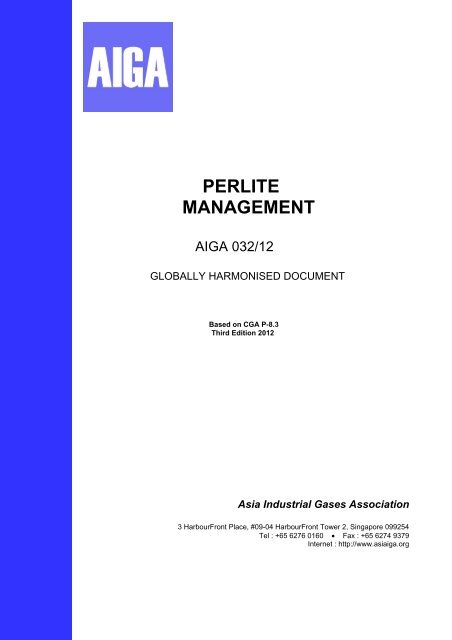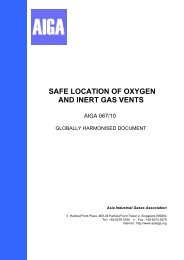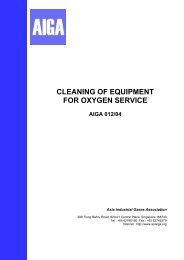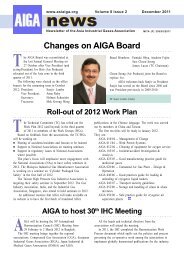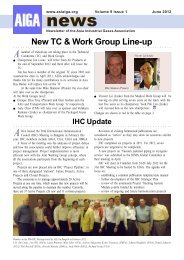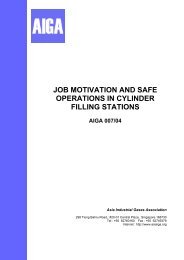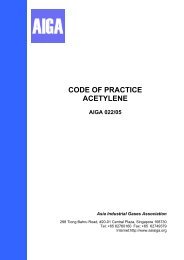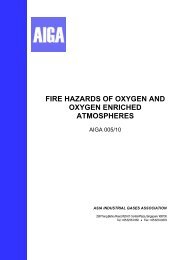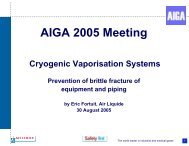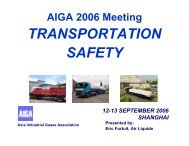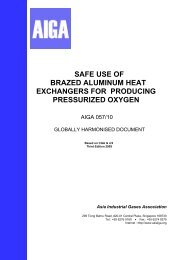Perlite Management (Harmonised publication) - AIGA
Perlite Management (Harmonised publication) - AIGA
Perlite Management (Harmonised publication) - AIGA
Create successful ePaper yourself
Turn your PDF publications into a flip-book with our unique Google optimized e-Paper software.
PERLITE<br />
MANAGEMENT<br />
<strong>AIGA</strong> 032/12<br />
GLOBALLY HARMONISED DOCUMENT<br />
Based on CGA P-8.3<br />
Third Edition 2012<br />
Asia Industrial Gases Association<br />
3 HarbourFront Place, #09-04 HarbourFront Tower 2, Singapore 099254<br />
Tel : +65 6276 0160 • Fax : +65 6274 9379<br />
Internet : http://www.asiaiga.org
Disclaimer<br />
<strong>AIGA</strong> 032/12<br />
GLOBALLY HARMONISED DOCUMENT<br />
PERLITE<br />
MANAGEMENT<br />
All <strong>publication</strong>s of <strong>AIGA</strong> or bearing <strong>AIGA</strong>’s name contain information, including Codes of Practice, safety procedures and other technical<br />
information that were obtained from sources believed by <strong>AIGA</strong> to be reliable and/ or based on technical information and experience<br />
currently available from members of <strong>AIGA</strong> and others at the date of the <strong>publication</strong>. As such, we do not make any representation<br />
or warranty nor accept any liability as to the accuracy, completeness or correctness of the information contained in these<br />
<strong>publication</strong>s.<br />
While <strong>AIGA</strong> recommends that its members refer to or use its <strong>publication</strong>s, such reference to or use thereof by its members or third<br />
parties is purely voluntary and not binding.<br />
<strong>AIGA</strong> or its members make no guarantee of the results and assume no liability or responsibility in connection with the reference to or<br />
use of information or suggestions contained in <strong>AIGA</strong>’s <strong>publication</strong>s.<br />
<strong>AIGA</strong> has no control whatsoever as regards, performance or non performance, misinterpretation, proper or improper use of any<br />
information or suggestions contained in <strong>AIGA</strong>’s <strong>publication</strong>s by any person or entity (including <strong>AIGA</strong> members) and <strong>AIGA</strong> expressly<br />
disclaims any liability in connection thereto.<br />
<strong>AIGA</strong>’s <strong>publication</strong>s are subject to periodic review and users are cautioned to obtain the latest edition.<br />
NOTE—Technical changes from the previous edition are underlined<br />
© Reproduced with permission from the Compressed Gas Association. All rights reserved.<br />
ASIA INDUSTRIAL GASES ASSOCIATION<br />
3 HarbourFront Place, #09-04 HarbourFront Tower 2, Singapore 099254<br />
Tel: +65 62760160 Fax: +65 62749379<br />
Internet: http://www.asiaiga.org
iii<br />
PAGE iii<br />
Contents Page<br />
1 Introduction..................................................................................................................................................... 1<br />
2 Scope ............................................................................................................................................................. 1<br />
3 Definitions....................................................................................................................................................... 1<br />
3.1 Verbal Forms....................................................................................................................................... 1<br />
3.2 Coldbox ............................................................................................................................................... 1<br />
3.3 Cryogenic ............................................................................................................................................ 1<br />
3.4 <strong>Perlite</strong> .................................................................................................................................................. 2<br />
3.5 <strong>Perlite</strong> releases.................................................................................................................................... 2<br />
3.6 Purge gas ............................................................................................................................................ 2<br />
4 Personnel safety............................................................................................................................................. 2<br />
4.1 Working with perlite ............................................................................................................................. 2<br />
4.2 Personal protective equipment............................................................................................................ 2<br />
4.3 Coldbox entry ...................................................................................................................................... 2<br />
5 Inspections and precautions........................................................................................................................... 3<br />
5.1 Atmospheric check .............................................................................................................................. 3<br />
5.2 Ice formation........................................................................................................................................ 3<br />
5.3 <strong>Perlite</strong> abrasion.................................................................................................................................... 3<br />
6 <strong>Perlite</strong> removal ............................................................................................................................................... 3<br />
6.1 Before perlite removal ......................................................................................................................... 3<br />
6.2 Coldbox perlite removal....................................................................................................................... 4<br />
7 <strong>Perlite</strong> installation ........................................................................................................................................... 5<br />
7.1 Packaging............................................................................................................................................ 5<br />
7.2 <strong>Perlite</strong> quality....................................................................................................................................... 5<br />
7.3 Filling to avoid insulation space voids ................................................................................................. 5<br />
7.4 Purge gas supply................................................................................................................................. 5<br />
7.5 Settling................................................................................................................................................. 5<br />
8 Disposal of perlite........................................................................................................................................... 6<br />
9 Emergency plan for perlite releases............................................................................................................... 6<br />
10 References ..................................................................................................................................................... 6
1 Introduction<br />
1<br />
<strong>AIGA</strong> 032/12<br />
This <strong>publication</strong> is one of a series compiled by the Compressed Gas Association, Inc. (CGA), in response to<br />
inquiries for information relating to perlite. <strong>Perlite</strong> is used as an insulation medium in cryogenic coldboxes, cryogenic<br />
liquid tanks, field-erected flat bottom tanks, and pipe ducts, where perlite is filled into the annular spaces<br />
between the inner and the outer shells.<br />
As part of the programme of harmonization of industry standards, the Asia Industrial Gases Association (<strong>AIGA</strong>)<br />
has adopted the original CGA standard P-8.3 as <strong>AIGA</strong> 032/12. This standard is intended as an international<br />
harmonized standard for the use and application by members of CGA, EIGA, JIMGA and <strong>AIGA</strong>. This edition<br />
has the same content as the CGA edition except for editorial changes in formatting, units, spelling and references<br />
to <strong>AIGA</strong> documents.<br />
2 Scope<br />
<strong>Perlite</strong> is nontoxic and nonflammable; however, the nature of the material and the large quantities involved require<br />
the use of special operations, handling, and safety procedures. This <strong>publication</strong> provides guidance for<br />
reducing the risks of unplanned perlite releases and incidents that could have potential for personal injury,<br />
property damage, downtime, and environmental impact.<br />
It covers the use of perlite in cryogenic coldboxes and cryogenic bulk storage vessels and focuses on safety,<br />
perlite handling procedures, and emergency perlite management. This <strong>publication</strong> is directed to industrial gas<br />
plant manufacturers, owners, and operators of facilities that utilize and maintain perlite as an insulation medium<br />
for cryogenic equipment. Insulating materials, such as rock wool or vermiculite and other synthetic silicates, are<br />
not covered in this <strong>publication</strong>. This <strong>publication</strong> does not cover hazards related to toxic and flammable gases.<br />
Information regarding design considerations, operation, and maintenance of cryogenic enclosures is contained<br />
in <strong>AIGA</strong> 079/12 Safe Design and Operation of Cryogenic Enclosures [1] 1 .<br />
NOTE—This <strong>publication</strong> does not attempt to recommend or establish specific design or usage criteria, but to provide best<br />
practices. The end user shall determine the specific requirements.<br />
3 Definitions<br />
For the purpose of this <strong>publication</strong>, the following definitions apply.<br />
3.1 Verbal Forms<br />
– Shall indicates that the procedure is mandatory. It is used wherever criterion for conformance to specific<br />
recommendation allows no deviation.<br />
– Should indicates that a procedure is recommended.<br />
– May and need not indicate permission and that the procedure is optional.<br />
– Will is used only to indicate the future, not a degree of requirement.<br />
– Can indicates a possibility or ability.<br />
3.2 Coldbox<br />
Cylindrical or rectangular enclosure, typically metal, surrounding the distillation columns and other cryogenic<br />
equipment.<br />
NOTE—The space between the columns and the inner coldbox shell is filled with insulation material, typically perlite.<br />
3.3 Cryogenic<br />
Temperatures below –130 °F (–90 °C).<br />
1 References are shown by bracketed numbers and are listed in order of appearance in the reference section.
3.4 <strong>Perlite</strong><br />
Inert volcanic glass that forms a lightweight powder aggregate when expanded by heat.<br />
2<br />
<strong>AIGA</strong> 032/12<br />
NOTE—<strong>Perlite</strong> is an odorless, nonflammable, nontoxic white to off white silicate powder. <strong>Perlite</strong> is a highly effective insulating<br />
material used to reduce refrigeration losses or heat leak into the coldbox, which would otherwise reduce production,<br />
increase power consumption, or both.<br />
3.5 <strong>Perlite</strong> releases<br />
Uncontrolled spillage of perlite to the environment.<br />
3.6 Purge gas<br />
Moisture free, oil-free inert gas.<br />
NOTE—For purge gas purity requirements, see <strong>AIGA</strong> 079/12.<br />
4 Personnel safety<br />
4.1 Working with perlite<br />
Operations and maintenance personnel involved in working with equipment that contains bulk perlite shall be<br />
trained in the safe and correct methods of handling perlite and its characteristics. This training shall be recorded.<br />
Installation and removal work crews shall be experienced in perlite handling and should be supervised.<br />
4.2 Personal protective equipment<br />
Expanded perlite is a nontoxic material, but the recommended protective equipment should be used as required<br />
for the particular task. Overalls, gloves, and hard hats should be used to prevent skin irritation.<br />
<strong>Perlite</strong> is lightweight and becomes airborne very easily. If perlite enters the eyes or respiratory tract, it can<br />
cause serious irritation. Eye protection shall be used to provide protection due to the dusting of handled perlite.<br />
CAUTION: If insulation enters the eyes, do not rub them. Flush the eyes immediately with water.<br />
If personnel must work in or enter an area with a high concentration of airborne perlite, they shall use a dust<br />
mask or full-face air-purifying respirator equipped with dust filters (NIOSH-approved or equivalent).<br />
CAUTION: A perlite product can contain crystalline silica, which is considered to be a nuisance dust. Inhalation<br />
of high amounts of any nuisance dust over long periods can overload the lung clearance mechanism and make<br />
the lungs more vulnerable to respiratory disease.<br />
Other safety considerations deal with the cryogenic fluids that can be entrained in the perlite during handling.<br />
4.3 Coldbox entry<br />
Entry into coldboxes involves many potential hazards, which include but are not limited to the following:<br />
– falling into the perlite and becoming submerged;<br />
– oxygen deficiency due to release of residual nitrogen purge gas or condensation of oxygen against cold<br />
surfaces;<br />
– oxygen enrichment due to leakages of oxygen-enriched liquid or liquid oxygen or from condensation of air<br />
against cold surfaces;<br />
– falling ice or blocks of frozen perlite caused by freezing of atmospheric moisture within the coldbox; and<br />
– leakage of perlite from adjacent coldboxes via coldbox interconnections.<br />
Never enter the enclosure until all confined space entry requirements have been met. These requirements are<br />
not defined within this <strong>publication</strong> (see OSHA requirements in 29 CFR 1910) [2]. (Additional references: <strong>AIGA</strong>
3<br />
<strong>AIGA</strong> 032/12<br />
005/10 Fire hazards of oxygen and oxygen enriched atmospheres [3] and <strong>AIGA</strong> 008/11 Hazards of inert gases<br />
[4]).Consult local authorities for additional procedures.<br />
Whenever possible, remove all perlite and sweep or wash down the casing to eliminate dust and slippery surface<br />
hazards. When a person is required to work on or above a perlite mass, an adequate working platform<br />
should be erected.<br />
5 Inspections and precautions<br />
5.1 Atmospheric check<br />
An atmospheric check should be completed periodically to verify that the insulation gas composition is the<br />
same as the purge gas. The use of oxygen monitors indicates only the presence or absence of oxygen.<br />
NOTE—For argon production plants where hydrogen is used to remove oxygen in the crude argon, it is possible for the hydrogen<br />
to leak into the coldbox. Periodic analysis of the coldbox annular space atmosphere for hydrogen should be completed.<br />
5.2 Ice formation<br />
External ice formation can indicate improperly installed perlite, inadequate coldbox maintenance, or a cryogenic<br />
gas or liquid leak. To eliminate ice buildup towards the top of the coldbox, the perlite level should be checked<br />
after perlite is added, when a problem is suspected, and/or during routine coldbox maintenance. The insulation<br />
will settle, especially after perlite is added to the coldbox, and the insulation level might need to be topped off.<br />
CAUTION: Use caution when checking the perlite level. The insulation space contains perlite and the purge<br />
gas, which is an asphyxiant.<br />
5.3 <strong>Perlite</strong> abrasion<br />
<strong>Perlite</strong> is abrasive. When entrained in a gas jet, perlite can cut through metal piping and equipment, damaging<br />
the equipment and allowing perlite to enter the process. The primary sources for such gas jets are either process<br />
leaks or damaged or broken piping inside the coldbox.<br />
6 <strong>Perlite</strong> removal<br />
CAUTION: Take steps to reduce the number of personnel in the work area. If possible, rope off the area and<br />
post warning signs to keep nonessential personnel away.<br />
6.1 Before perlite removal<br />
Perform the following steps before perlite removal:<br />
a) Shut down the cryogenic process;<br />
b) Drain all cryogenic liquids from the process equipment and piping;<br />
c) Warm the process equipment and piping to a safe working temperature. If liquid pooling is potentially present,<br />
precautions shall be taken to protect personnel from at minimum: perlite eruption; engulfment; cryogenic<br />
exposure; and asphyxiation;<br />
d) After the piping and equipment have been warmed, stop the warming process and depressurize the<br />
equipment to a safe working pressure;<br />
e) Stop the purge gas flow to the coldbox insulation space and physically isolate the purge gas supply. This<br />
can be accomplished by the removal of a section of the piping or the insertion of a blind flange; and<br />
NOTE—For HYCO facilities, all flammable and toxic materials shall be purged from the coldbox and process piping.<br />
f) Open a top manhole before removing perlite to protect against a possible casing collapse by developing a<br />
vacuum during the perlite removal process.
6.2 Coldbox perlite removal<br />
6.2.1 Monitoring<br />
4<br />
<strong>AIGA</strong> 032/12<br />
The insulation space gas composition should be monitored continuously for the presence of excessive oxygen,<br />
combustible gases, or both. The composition should be checked along the height of the coldbox. If a high concentration<br />
(oxygen greater than 5% when purging with nitrogen or greater than 23% when purging with dry air)<br />
is detected, the manhole should be closed and a purge reinstated. Continue the purge until the oxygen concentration<br />
in the vent gas drops below these levels.<br />
6.2.2 Removal process<br />
To lessen the risks of uncontrolled perlite releases, removal of perlite should take place from the top of the<br />
coldbox and proceed downward. This reduces both the potential for perlite bridging (agglomeration of the powder<br />
into a solid mass) and the amount of perlite that might be expelled from the casing should an uncontrolled<br />
release occur.<br />
<strong>Perlite</strong> eruptions can be caused by, but are not limited to the following:<br />
– coldbox overpressurization due to equipment or process line failure, including purge gas overpressurization;<br />
– local overpressurization due to rapid vaporization of liquid that can occur when cryogenic liquid is pooled in<br />
the perlite, and the perlite is physically disturbed or the pool of liquid is suddenly warmed;<br />
– structural failure of the insulation containment device due to operating conditions (such as vacuum), embrittlement,<br />
or external loading; or<br />
– mishandling during emptying operations.<br />
<strong>Perlite</strong> removal nozzles should be used if they are provided. If cryogenic liquid is known to have collected in the<br />
perlite, it should not be withdrawn from the bottom of the coldbox; flashing in a fully perlited coldbox will result in<br />
an uncontrolled release.<br />
An open-top perlite collection box should be used if perlite is removed using equipment not designed for oxygen<br />
service (for example, vacuum blowers found on commercial vacuum trucks). This allows for degasification<br />
of the perlite (escaping gas or vaporizing liquid) and prevents a possible oxygen-enriched atmosphere, which is<br />
a fire hazard.<br />
Proceed cautiously if the perlite is suspected of containing cryogenic liquid that might lead to a hazardous atmosphere<br />
in the perlite collection box.<br />
The insulation space pressure at ground level and at the level from which perlite is being withdrawn should be<br />
monitored using a manometer or gauge. If the pressure starts to increase, it can be an indication of an imminent<br />
perlite release and perlite removal should be stopped immediately.<br />
6.2.3 Residual perlite<br />
When the majority of perlite has been removed, residual perlite removal might be required. If removal of residual<br />
perlite requires entry into the coldbox, follow regulatory and safety procedures including the following:<br />
a) Monitor the annular space for safe oxygen content;<br />
b) Check the interior for ice blocks and remove large blocks by thawing, either mechanically or by judicious<br />
use of steam;<br />
c) Remove residual perlite by brushing, shoveling, or, if only absolutely necessary, washing surfaces with<br />
water; and<br />
d) Take care not to disturb or break small bore lines in the vicinity of the perlite clean-up operation.
7 <strong>Perlite</strong> installation<br />
7.1 Packaging<br />
5<br />
<strong>AIGA</strong> 032/12<br />
For small coldboxes or where only small quantities of perlite are required, either siloed or bagged perlite may<br />
be charged directly through manholes at the top of the coldbox. Bulk shipments of expanded perlite can be<br />
made in closed-type tanker trailers equipped with a transfer hose to discharge the perlite directly into the coldbox<br />
or into the annular space of a tank. The tanker shall be equipped to prevent moisture entry into the perlite<br />
during transport. The inside of the tanker should be clean.<br />
For a large coldbox, expansion “popping” of the perlite ore at the plant location can be more efficient. A knowledgeable<br />
contractor should complete this operation and provide all the necessary equipment and services.<br />
7.2 <strong>Perlite</strong> quality<br />
<strong>Perlite</strong> deteriorates each time it is handled. Before reuse, the perlite should be inspected for the following properties:<br />
– loose density;<br />
– compacted density;<br />
– sieve analysis;<br />
– free moisture content; and<br />
– organic material content.<br />
NOTE—If the perlite is reused, there is normally some attrition and the coldbox should be topped off with fresh perlite.<br />
7.3 Filling to avoid insulation space voids<br />
There are several methods to fill coldboxes without creating pockets or insulation voids:<br />
– <strong>Perlite</strong> may be introduced in stages to help reduce voids. First, add perlite at lower levels. Then, proceeding<br />
up the coldbox, add perlite through higher fill ports;<br />
– Top fills are used when staged fills are not used or when topping off the insulation space; and<br />
– When practical, vibration equipment or rubber mallets used to tap on the coldbox exterior can be used to<br />
induce perlite settling, thus avoiding pockets or voids.<br />
7.4 Purge gas supply<br />
Once the insulation space is filled with perlite, all column entry points shall be closed and the purge gas supply<br />
should be immediately placed into service.<br />
7.5 Settling<br />
After coldbox cool down and operation has commenced, settling of perlite normally occurs. The top of the coldbox<br />
should be inspected and topped off with additional insulation as necessary.<br />
CAUTION: Use caution when checking the perlite level. The insulation space is pressurized with the purging<br />
gas, which is most likely to be nitrogen (an asphyxiant). A self-contained breathing apparatus might be needed<br />
to ensure the safety of the inspection personnel from asphyxiating gas discharged at them from the opening. A<br />
standby person also might be needed in the event of an emergency. Depending upon the size of the opening<br />
used to make the inspection and the potential for falling into the cryogenic enclosure, fall protection gear also<br />
might be used. If inspection personnel must break the plane of the coldbox penetration to make the inspection,<br />
a permit-required confined space entry might have to be conducted.
8 Disposal of perlite<br />
6<br />
<strong>AIGA</strong> 032/12<br />
Disposal of perlite might be governed by national or local environmental regulations. If contamination is suspected,<br />
conduct appropriate testing to determine whether the material is hazardous or not, as defined by applicable<br />
national or local hazardous waste regulations. Nonhazardous contaminated perlite may be regulated as<br />
industrial solid waste in certain states. Check with local authorities for applicable regulations.<br />
Noncontaminated perlite can be disposed of or recycled as governed by national or local environmental regulations.<br />
9 Emergency plan for perlite releases<br />
Facilities that use perlite should have an emergency plan that addresses perlite releases. The emergency plan<br />
should address who is to be called if there is a perlite release. The emergency plan should be reviewed periodically<br />
to ensure that the information is accurate and up to date. The plan can list several companies with local<br />
disposal sites. Many landfills require prior approvals so that when disposal is required, the paperwork has already<br />
been completed and perlite can be accepted quickly.<br />
Personnel shall receive training on the emergency plan and shall be notified when substantive changes to any<br />
emergency response procedures are made.<br />
At a minimum, the emergency plan should include the following procedures:<br />
a) Secure the plant processes as required;<br />
b) Evacuate personnel and conduct a headcount;<br />
c) Check perlite material safety data sheets (MSDS) for any required first aid/emergency procedures;<br />
d) Contact emergency response agencies and offsite neighbors, as required;<br />
e) Vacuum clean or wet sweep to avoid dusting;<br />
f) Take necessary measures to prevent migration of any spilled perlite into a waterway via wind or storm water<br />
releases;<br />
g) Secure adjacent processes from perlite ingestion; and<br />
h) Contact qualified clean-up and perlite disposal contractors.<br />
10 References<br />
Unless otherwise specified, the latest edition shall apply.<br />
[1] <strong>AIGA</strong> 079/12, Safe Design and Operation of Cryogenic Enclosures, Asia Industrial Gases Association<br />
[2] Code of Federal Regulations, Title 29 (Labor), Superintendent of Documents, U.S. Government Printing<br />
Office, 732 North Capital Street, NW, Washington, DC 20401. www.gpo.gov/fdsys<br />
[3] <strong>AIGA</strong> 005/10 Fire hazards of oxygen and oxygen enriched atmospheres, Asia Industrial Gases Association<br />
[4] <strong>AIGA</strong> 008/11 Hazards of inert gases, Asia Industrial Gases Association


